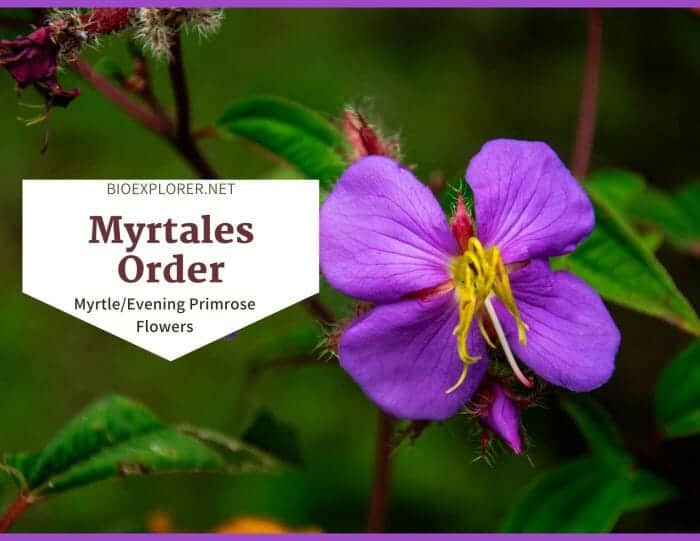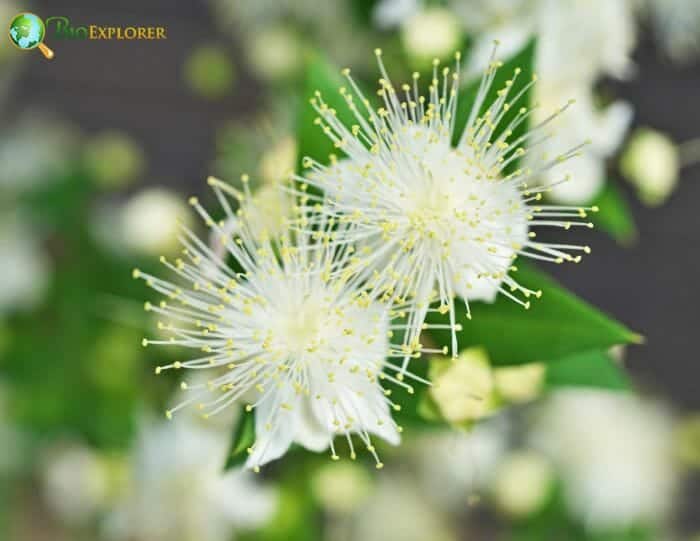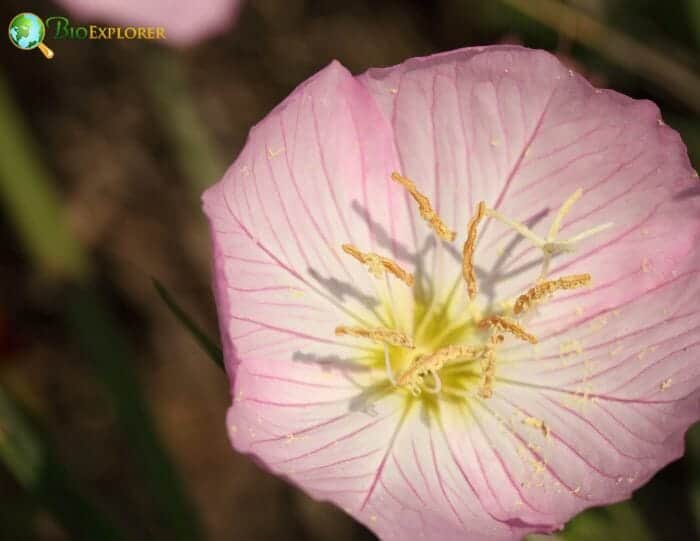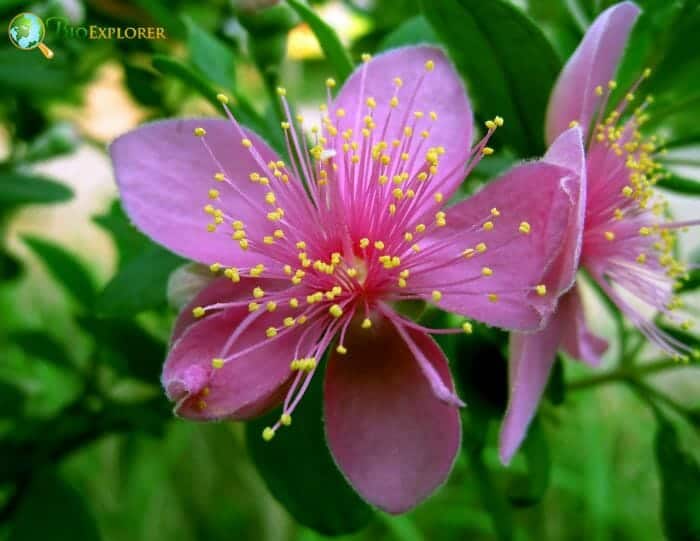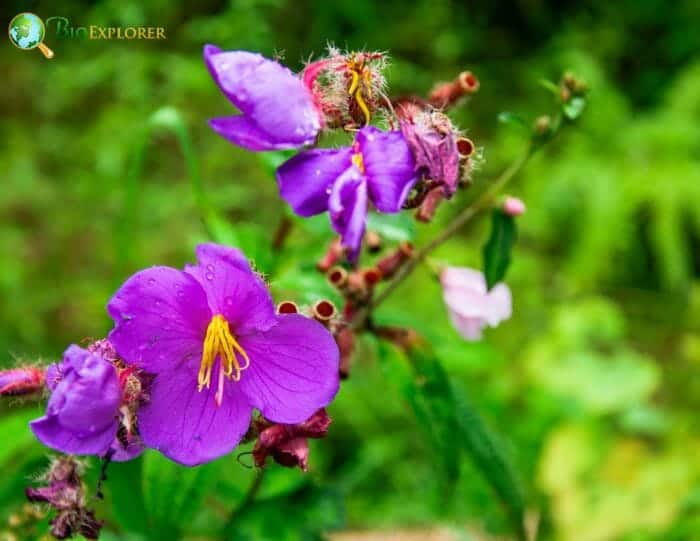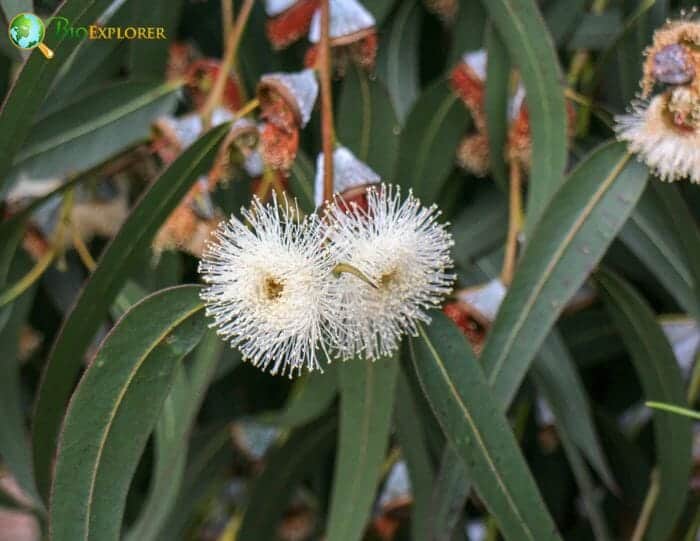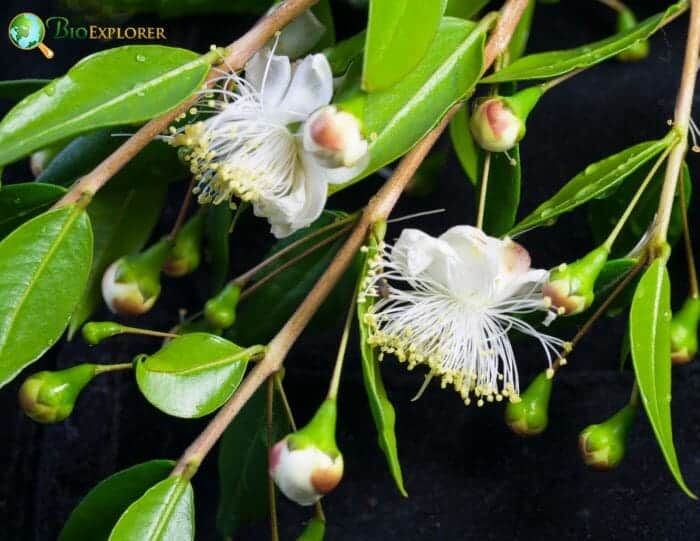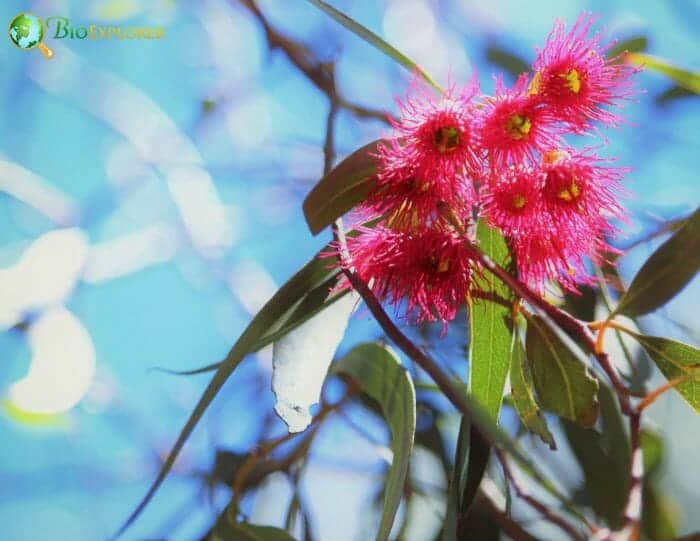Myrtales, the Myrtle order, are trees, shrubs, herbs, and lianas primarily distributed in the tropics and warmer regions worldwide. Myrtales members have phloem tissue on each xylem side, 4 or 5 sepals, 4 or 5 petals, mostly bisexual flowers, and often non-endospermic seeds. Known species of Myrtales are myrtles, evening primroses, Fuschia, and Eucalyptus.
Table of Contents
Myrtales Families
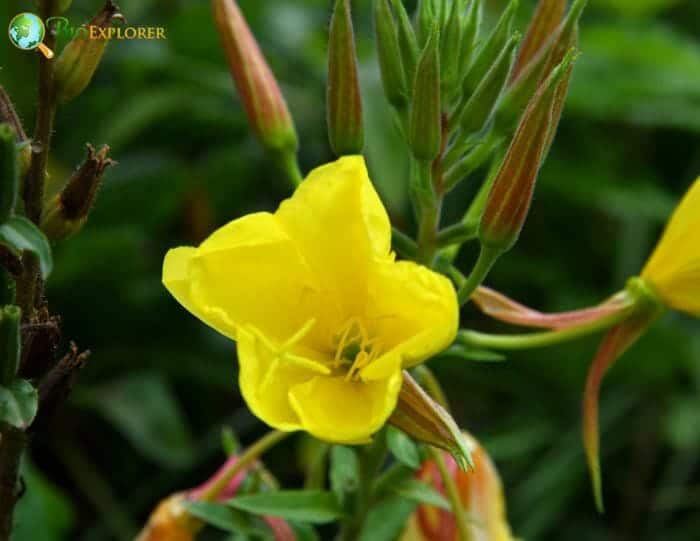
APG III classification system places Order Myrtales under Eurosids with 9 families, 380 genera, and 13,000 species.
- Alzateaceae
- Combretaceae (White mangrove family).
- Crypteroniaceae
- Lythraceae (Loosestrife family)
- Melastomataceae (Melastome family)
- Myrtaceae (Myrtle family)
- Onagraceae (Evening Primroses family).
- Penaeaceae
- Vochysiaceae
Myrtales Distribution
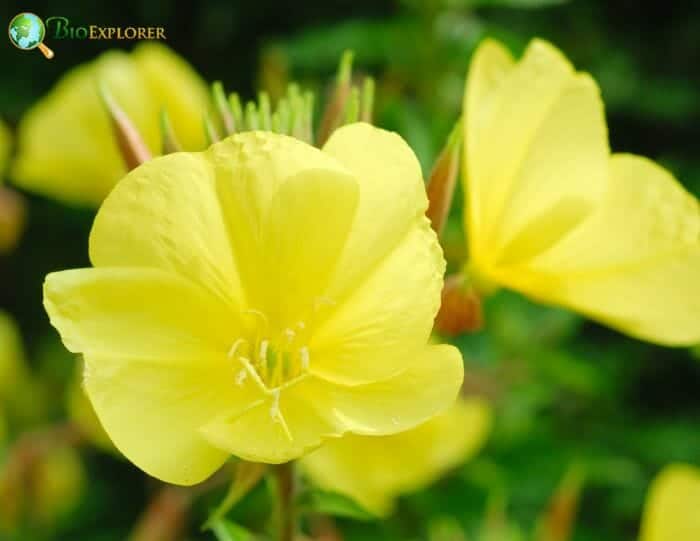
The species of the order Myrtales are distributed in the tropics and the warmer regions worldwide. In addition, a few species are found in temperate regions.
- The most numbered families of Myrtales are Melastomataceae (167 genera and 4,079 species[1] ) and Myrtaceae (144 genera and 5,774 species).
- Melastomataceae is one of the most prominent families of flowering plants and is distributed throughout the tropical and subtropical regions of the world.
- The plants of Myrtacaea are mostly found in the Southern hemisphere.
- The evening primrose family, Onagraceae (43 genera and 720 species), has a worldwide distribution.
- The Combretaceae family (17 genera and 480 species)[2] are most abundant in the tropics and the subtropics.
- Finally, the Lythraceae family with 31 genera and 604 species has a worldwide distribution.
Myrtales Characteristics
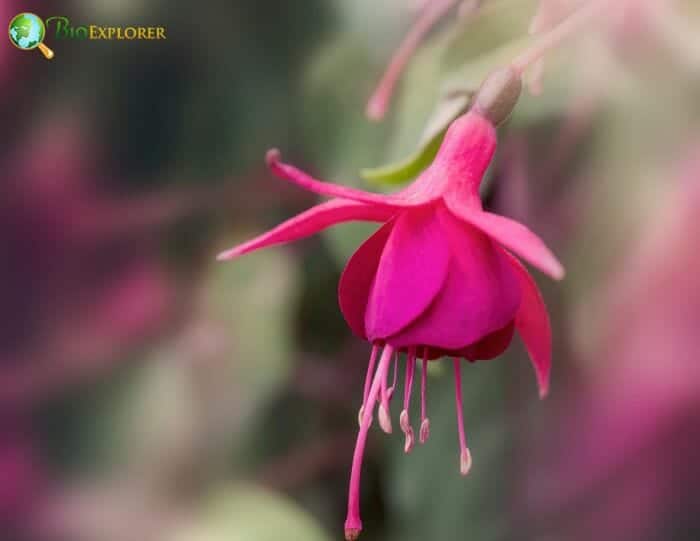
- Plant type: Members of the Myrtales are trees, shrubs, herbs, and lianas.
- Stem: Each side of the xylem vessels has phloem tissue. There is a sievelike appearance in the pits of the vessels. Lignotubers are present in the Myrtaceae. Most of the stems are 4-sided.
- Leaves: Most members of the Myrtales have opposite, simple, and entire leaves. Some species have alternate and whorled leaves. Most stipules are diminutive.
- Flowers and Inflorescences: The flowers are mostly bisexual, and the inflorescence is a variable.
- Sepals and Petals: Most flowers of Myrtales are 4 or 5-merous.
- Stamens and Carpels: The stamens of the flowers vary in number. But often, they are in two whorls or grouped in bundles. The carpels of the flowers are 2-5.
- Ovary and Fruit: The ovary is superior or inferior. The fruit is usually a berry or a capsule. Others are in drupe, nut, nutlet, or samara.
- Seeds: Most seeds are non-endospermic and exalbuminous.
Myrtales Flowers and Reproduction
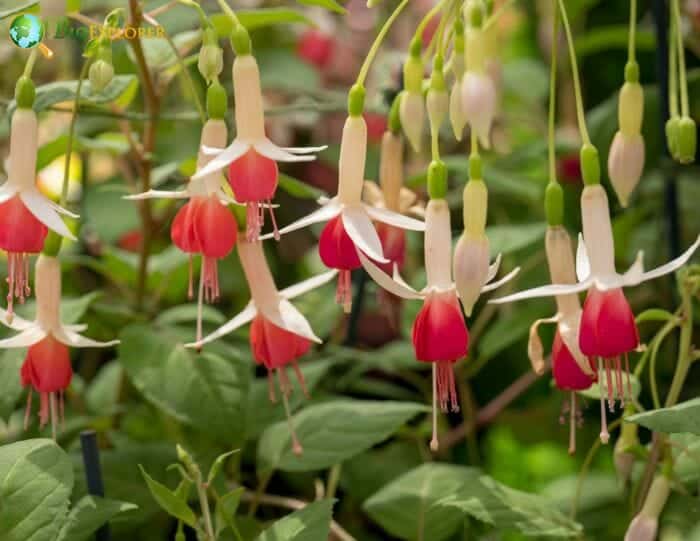
- Myrtaceae flowers are bisexual and actinomorphic. The inflorescence of the flowers is a variable. However, usually, Myrtaceae flowers are of cyme type. The Eucalyptus flowers are pedicellate, while the Callistemon are sessile. The Callistemon flowers have 2 bracteoles, while the Eucalyptus species do not have bracts.
- Myrtaceae flowers usually have 4-5 sepals in the calyxWhat is calyx?A collective term for all the sepals of a flower; the lowermost whorl of floral orgrans (Plural form is calyces).. Some species have 0 sepals. The petals are usually 4-5. The small 5-petaled flowers of the myrtle are white, pink, and purple. The Myrtaceae stamens are indefinite, and the carpels are 2 to indefinite. The nectaries are present. The flowers of the Myrtaceae are generally entomophilousWhat is entomophilous?Pollination by insects. Contrast anemophilous (wind-pollination)..
- Melastomataceae[4] flowers are bisexual, perigynous, or epiperigynous and are mostly in cymes. The hypanthiumWhat is hypanthium?It is a floral tube created by the fusion of the basal parts of the sepals, petals and stamens; the rest of the flower parts emanate from this. is present in the perianth of the flowers; typically, there are 4-5 valvateWhat is valvate?Sepals having adjacent edges abutting rather than overlapping; opening by valves; edges of structures coming together so that the margins touch but won't overlap. or calyptrate sepals in the calyx and 4-5 convolute petals in the corollaWhat is corolla?A collective term referring to the petals of a flower..
- Other Melastomataceae species consist of 3-10 sepals and petals. The Melastoma[5] species with dark pink to bright purple flowers and 5 petals are planted worldwide.
- The Melastomataceae androecium has 8 or 10 biseriate stamens and poricidal anthers. The gynoeciumWhat is gynoecium?It is a collective term for all carpels (female parts) in a flower. Carpels can be either apocarpous (separate) or syncarpous (combined or united) comprises a superior or inferior ovary, usually 3-5 carpels and locules. Most flowers of the family Melastomataceae are nectarless. Pollination is done mainly by the pollen-collecting bees.
- Most Onagraceae flowers are bisexual and actinomorphic. Some, however, are unisexual or monoeciousWhat is monoecious?Pertaining to plants, individuals of which bear both staminate and pistillate flowers, but not necessarily perfect flowers. (Fuchsia). The flowers are in the inflorescence of a spike, panicle, raceme, or solitary. The flowers have 4 separate sepals in the calyx. These sepals are inserted in the hypanthium. The corolla has 4 separate, often clawed petals.
- Other species have 0 or 2 petals. The evening primroses of the genus Oenotheras have four large and showy petals with pink, white, or yellow color. Most Oenothera flowers bloom at night.
- However, most of the flowers will remain open at midday. The attractive Fuchsia flowers with pendulous teardrop shapes have four long, slender, and bright red sepals. The corolla is made up of four broad and purple petals. The colors can vary depending on the variety. In general, the pollination of the Onagraceae species is anemophilousWhat is anemophilous?Referring to flowers which are wind-pollinated; other type is entomophilous (insect-pollinated) or entomophilous.
- Lythraceae plants are hermaphroditesWhat is hermaphrodites?Having both male and female reproductive organs. and pollination is entomophilous. The flowers are solitary or in the inflorescence of cymes, panicles, racemes, or verticils. The calyx and the corolla are often distinct in the perianth.
- The Lythraceae flowers are rarely sepaline and often 4-merous or 6-merous. The petals of the corolla are clawed or sessile and are often red, purple, and orange. Free hypanthium is present in the flowers.
Myrtales Family Differences
Order Myrtales is comprised of 9 families. Therefore, the comparison in this section is just among the 5 families with the most numbered species.
Myrtaceae
- Members of the Myrtaceae are mostly trees or shrubs. A few species are herbs.
- The stems of the Myrtaceae are woody and branched. Trees have very shining bark. The vascular bundle of the species is bicollateral.
- The leaves of the members are simple, opposite, alternate, or whorled. The leaves are exstipulateWhat is exstipulate?Without stipules; Stipule is a small structure of appendage found at the base of some leaf petioles. (minute stipule if present) and shortly petiolate.
- The flowers are bisexual and actinomorphic. The inflorescence is a variable.
- The sepals of the calyx are 4-5; imbricateWhat is imbricate?overlap or cause to overlap; in botany terms, scales, sepals, or plates having adjacent edges overlapping; with margins of structures overlapping like shingles on a roof.. There are also 4-5 petals in the corolla.
- The stamens of the Myrtaceae species are 8[6]. The carpels are usually 2-5. Other species can have a maximum of 16.
- Most of the flowers have an inferior ovary. The fruit is a berry or a capsule. In rare instances, the fruit is a drupe or nut.
- The seeds are non-endospermic.
Melastomataceae
- The plants of the Melastomataceae are shrubs, herbs, trees, or lianas.
- Most of the Melastomataceae have 4-sided stems.
- Plants have simple, opposite, and rarely whorled leaves. Usually, the leaves are exstipulate.
- The Melastomataceae flowers are bisexual, and the inflorescence is a cyme.
- Usually, 4-5 valvate or calyptrate sepals and 4-5 convolute petals. Other species have 3-10 sepals and petals.
- The biseriate stamens are typically 8 or 10, and the syncarpousWhat is syncarpous?Flowering having united carpels; Contrast apocarpous. gynoecium often has 3-5 carpels.
- The ovary of the flowers is superior or inferior, and the fruit is a capsule or berry.
- The seeds of the fruit are exalbuminous.
Onagraceae
- The species of Onagraceae are herbs and rarely trees or shrubs.
- The leaves of the Onagraceae are alternate or opposite, simple, and exstipulate.
- The flowers of the evening primroses are bisexual. They are solitary or in a raceme, spike, or panicle.
- The sepals in the calyx are 4; separate. The petals in the corolla are 4, separate and clawed.
- The androecium is uniseriate or biseriate, The stamens are 4 or 8. The gynoecium has 4 united carpels.
- The Onagraceae flower’s ovary is inferior, and the fruit is a capsule. A few have nutlet or berry.
- The seeds of the fruit are non-endospermic.
Lythraceae
- Members of the Lythraceae family are herbs, shrubs, and trees.
- The leaves of the Lythraceae plants are usually opposite and rarely whorled or alternate. These leaves are stipulate (with small stipules) or exstipulate. The lamina and the lamina margins are both entire.
- The flowers are bisexual. The Lythraceae flowers are solitary or aggregated in cymes, panicles, racemes, or verticils.
- The sepals are 4, 6 or 8. The petals are also the same. Some species lack petals.
- The stamens of Lythraceae flowers are twice as many as the petals. The carpels are usually 2 to 6.
- The ovary of most species is positioned superior. The fruit is a capsule or capsular.
- The seeds of the fruits are non-endospermic. Some genera are winged.
Combretaceae
- Species of Combretaceae are trees, shrubs, and lianas.
- The leaves of the Combretaceae plants are simple, opposite, alternate, or whorled. The leaf and leaf margins are entire. The stipules are small or absent in some species.
- The flowers are bisexual or sometimes unisexual. The flowers are in racemes, spikes, or heads.
- The sepals and the petals are 4-5 in the calyx and the corolla, respectively. Other species lack corolla.
- The androecium is often 10. Other species have 4-8, 11-100. There are 2-5 carpels in the gynoecium.
- The ovary is inferior. The fruit is a drupe, capsule, or samara.
- The seeds of the fruit are endospermic. Therefore, there is only 1 seed per fruit.
Myrtales Example Species
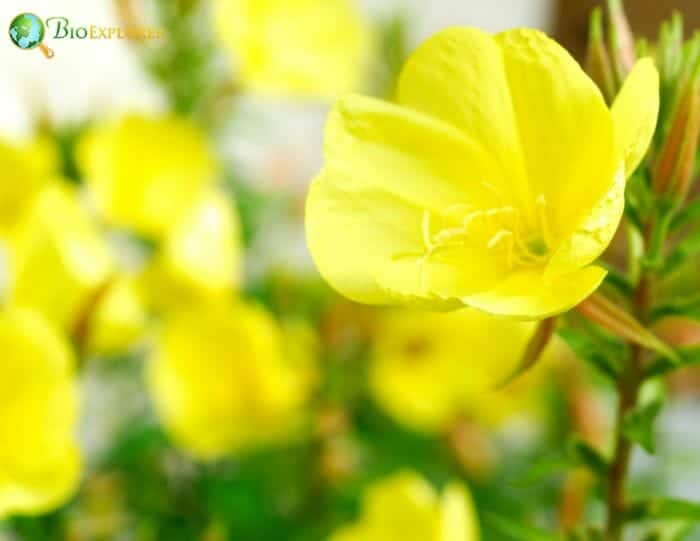
Many plants of the Myrtales are economically and ecologically important. Below are some of the beneficial species under the Myrtales order.
- Thailand powderpuff[7]: Thailand powderpuff is an ornamental flower with landscaping features. The roots of this species are medicinal.
- Dactylocladus stenostachys: The tree’s wood is one of the most imported timbers in Borneo.
- Purple loosestrife: Purple loosestrife is a plant widely used in traditional medicine.
- Princess flower: The Princess flower is used as an ornamental plant. Also, it has medicinal and pharmaceutical uses.
- Malabar melastome: The leaves and flowers of the plant have chemical contents and properties for medicinal uses.
- True myrtle: True myrtle is an ornamental plant. It is also used as spices and culinary herbs. In addition, the plant produces dye and essential oils. The wood of the myrtle is used for timber. Further, the myrtle plant is used in traditional medicine.
- Small-leaved Fuchsia: The fuchsia is usually used as an ornamental plant. The fruit is edible, raw, or cooked.
- Dwarf fireweed/River beauty willowherb: The plants’ flowers, roots, shoots, and stems are edible. The entire plant of the River beauty willowherb is used in Tibetan medicine.
- Evening primrose: The evening primroses are garden plants. They also produce oil and fats. Also, this plant is used in traditional medicine.
- Southern blue gum: Environmental uses of this plant involve Agroforestry, erosion control, windbreak, and shade and shelter. The leaves of this species are processed to extract Eucalyptus oil. The timber of the Southern blue gum is used in construction. It is also used in making charcoal, fuelwood, furniture, and other wood products. Further, the Southern blue gum is also considered an ornamental plant. It is also used in traditional medicine.


